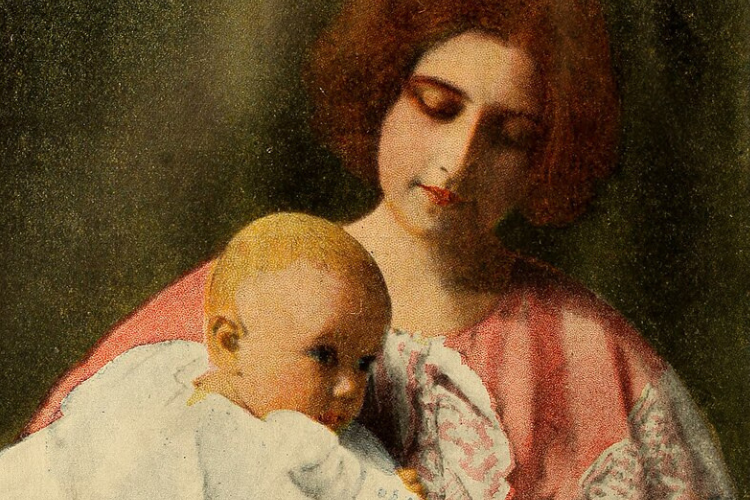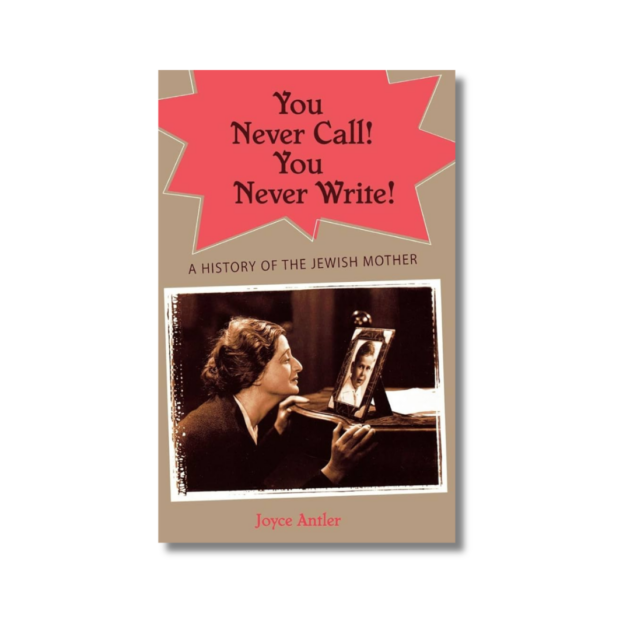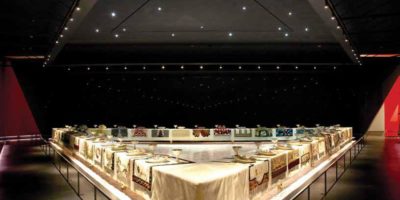
“The Mother and her First-born,” by Owen Zimmerman.
The REAL History of the Jewish Mother
Susan Schnur: Let’s begin by pretending that we didn’t just talk about our children for 15 minutes.
Joyce Antler: I can live with that.
Schnur: You’ve written a scholarly book that is totally fun to read, aside from being full of Jewish mother jokes. Are your colleagues jealous?
Antler: (Laughs.) I don’t know about that. But I’m on a mission with this book — I want to reach a very broad audience —
Schnur: In both senses of the word…
Antler: To reclaim the Jewish mother. To investigate the historical origins of the negative stereotype — the Jewish mother as suffocating, domineering, meddling — and to reveal who we really are, and were. Our strengths, our powers of nurturance, our values, competence, rebelliousness, devotion to family, our wit, our resilience.
Schnur: You start your book a century ago with Georgie Jessel’s famous one-sided conversations with his Mama—this was his most popular vaudeville act.
Antler: Yes. “Hello, Mama. This is George. Isn’t it nice to have your own phone? What? Nobody calls you? Even before you had the phone, nobody called you either?”
Schnur: This is affectionate.
Antler: It is. And then we see pernicious permutations. “What’s the difference between a Rottweiler and a Jewish mother? Eventually, the Rottweiler lets go.”
Schnur: You see this as both misogynist and anti-Semitic.
Antler: I do. And then we see mothers who appropriate the stereotype, turning it on its head. Alan Dershowitz, the famous Harvard law professor, was once arguing with his mother when she suddenly said, “What’s the difference between a terrorist and a Jewish mother?” “With a terrorist,” she answered, “you can sometimes negotiate.” That’s wonderful. She’s quite pleased to be this kind of mother.

Schnur: You argue throughout your book, Joyce, that evolving representations of the Jewish mother are a very clear lens through which to understand American-Jewish history. Tell us about Sophie Tucker, and her extraordinarily sentimental hit ballad, “My Yiddishe Mama.” It’s a peephole into a very complicated Jewish-American era.
Antler: “My Yiddishe Mama” drew upon the tradition of ethnic nostalgia songs. The National Origins Act of 1924 closed the immigration gates; Tucker’s song was written in 1925. The immigrant mother — or the lonely mother left behind in East Europe begging for her son to write home (as in the song “A brivele der mamen”) — became tragic and mythologized, celebrated for her nurturing self-sacrifice. Despite poverty, the lyrics go, “there was always enough for the children” to eat because Mama “used to give us bread from her mouth.”
The deep emotions of the Yiddish lyrics — the Americanized English ones are more quaintly Victorian than ethnically Tin Pan Alley — reveal how intensely Jews experienced the separations demanded by acculturation. The world of the past was vanishing. The second-generation American Jew had to move away from Mama, physically and emotionally; had to feel the pull of loneliness. The mourning is coupled with uncertainty and guilt. The appeal of this song was extraordinary.
Schnur: But the Sophie Tucker plot thickens. You write that “even in that early period, multiple contradictory images of the Jewish mother proliferated.”
Antler: That’s true. For one, Tucker herself was no “nice Jewish girl” or even “Yiddishe Mama.” She was a big, sexy “redhot Mama” who belted out risqué songs in her nightclub acts and had a raucous sense of humor. Tucker had left home in defiance of her mother, abandoning her infant son in order to pursue her dream of a stage career. That’s an interesting kind of Jewish mother! Needless to say, her mother disapproved of her.
Schnur: And the song was written under bizarre circumstances.
Antler: Sophie was traumatized when her mother died. After Jennie’s funeral, Sophie became “paralyzed” in the middle of a performance, and had to be physically carried from the stage. She was unable to work after that. Her songwriter and accompanist wrote “My Yiddishe Mama” in an effort to resuscitate her. And it worked.
In fact, Jennie Abuza wasn’t in any way the sorrowful, abandoned tenement mother that the song celebrates, but a tough woman, a social activist, a progressive, a mainstay of her Jewish community in Hartford, Connecticut. Later in life, Tucker raised money for Israel and for children’s and women’s causes, and she liked to call herself “just a Yiddishe Mama, begging, pleading and weeping, like Mother Rachel for her children.”
Schnur: Amazing that she pulls up the biblical image of Rachel as a “Yiddishe Mama.”
Antler: I know. Tucker saw her mother’s ideals in the work of women of her generation who served “their synagogues, their sisterhoods, their community centers, their settlements” and homes. In a fundraising speech at the end of her life, she said, “I ran away from the ghetto in Hartford, but I’ve been running back to it and to Mama ever since.”
Schnur: As Walt Whitman would say, Tucker “contained multitudes.” You make extraordinary points in relation to Al Jolson’s Jewish “Mammy;” in relation to the portraits of Jewish mothers (and defeated Luftmenschen fathers) in novels like Jews Without Money, The Rise of David Levinsky, Yezierska’s Bread Givers, Henry Roth’s Call It Sleep, Kazin’s A Walker in the City; and in the films and dramas of the 1920s and ‘30s, like Odets’s Awake and Sing!—it’s hard not to press you to say more about each of these. But I was particularly taken by some comments from New York City’s commissioner of health in the 1920s.
Antler: Many social reformers saw immigrant Jewish mothers as backward and unrefined, but then I came across a commissioner who said, “The Jewish mother is a wonderful mother.” Jewish babies on the impoverished Lower East Side are healthier than those of “Fifth Avenue,” he said, because Jewish mothers nurse their own babies and go to milk stations for pure milk for their older children. A director of a clinic who worked with different immigrant mothers said that the Jewish mother was “the most sacrificing mother in the world. Continually progressive — eager to learn.” She sought out the most up-to-date advice from officials, unlike other foreign-born mothers. “The Board of Health is second only to the Almighty in her eyes.”
Schnur: Uh-oh. One senses this veering into “my son, the doctor” territory…
Antler: There is the beginning of a shift in the image of the Jewish mother through these years. She is adaptive, energetic, pragmatic, but her success in acculturating her family, in succeeding in America, begins to turn her into a threat.
Schnur: Her formidable role in the family — her centrality and competence and orchestration of the family’s upward mobility — seems to lead to her sons’ shame about their dependency. They become “Mama’s boys,” and the resolution seems to be “matricide” — the need to shame Mom in return, to marginalize her, by portraying her negatively, as suffocating, shrewish, grasping…
Antler: But before we go there, I want to say a word about Gertrude Berg, who really invented the TV family sitcom. She wrote more than 10,000 scripts-
Schnur: Wow.
Antler: — and starred as “Molly Goldberg” in radio and then TV shows for over 30 years. Her version of the Jewish mother straddles competing images, and is just brilliant.
Schnur: You write about Molly Goldberg becoming a “surrogate mother” to millions of Americans.
Antler: She was. She had a Yiddish accent, wore an apron, had family-centered values, and hung out her kitchen window — she was the sentimentalized Yiddishe Mama — but Berg used that image subversively. On the show Molly Goldberg has very progressive ideas, especially about parenting, psychology and education. She challenges traditional gender norms and is a risk-taker. In an era defined by compliance to medical “childhood experts,” she stressed mothers’ own competence and authority.
Schnur: You mention in your book that a woman in a mother’s group on Berg’s show says, “If you ask me, maybe the college professors can come and learn a lot from us.”
Antler: This kind of female confidence is very unusual in that era, but characteristic of Jewish mothers. Berg, in her newspaper columns, was also anti-war — she saw mothers as being able to abolish war through their parenting. She also refused to fire her TV husband when he was blacklisted. Gertrude Berg herself, by the way, was very cosmopolitan. She lived handsomely on Park Avenue, took a great interest in Freud, collected modern art, had a cook and a butler, and celebrated Christmas with a four-and-a-half foot tree.
Schnur: I love this. Who knew? I’m interested in her daughter’s saying that Berg would have been “a terrible mother if she hadn’t had a career.” Because it feels to me that the decades in which Jewish mothers are portrayed with the most hostility and ridicule—as nagging, devouring, aggressive, materialistic, over-identified with their children — coincide with an era, the late ‘40s through the ‘60s, in which Jewish women’s “worlds” became severely restricted. We were no longer wage-earning — and we had been for centuries in Eastern Europe. We were largely ghettoized in our homes — in this new place called “the suburbs” — with our outsized competence and appetites having insufficient outlet.
Antler: I’d have to agree. But Jewish women also played vital roles in their communities during this era; they were energetic and activist. They contributed a lot.
Schnur: So you also have this shocking chapter, Joyce, on Margaret Mead. In the late ‘40s, she and Ruth Benedict — who I think was also her lover? —
Antler: Yup.
Schnur: — directed a gargantuan cross-cultural research team that looked at 16 nationalities. One of the projects of this team was the famous book Life Is with People: The Culture of the Shtetl, by Zborowski and Herzog, a study of Ashkenazi culture. The book is still widely cited today.
Antler: In the aftermath of the Holocaust, Mead wanted to reclaim the Jewish past in a positive way. The four-year study successfully does this, but it also — more than two decades before Portnoy’s Complaint — enshrines a narrow and monolithic portrait of the Jewish mother as whining, melodramatic, intrusive. Constantly worrying, over-feeding her children, incessantly wounded. Mead comments on Jewish women’s “masochism” — how gratifying we find it.
The “model Jewish mother is the womb,” she says — meaning that our sons are perpetual babies to us, not children who grow into men. Ruth Landes, a collaborator of Zborowski’s, was central to the creation of this image, and she personally hated her mother, whom she saw as domineering and controlling.
Schnur: You quote Landes as saying, “My fear of marriage and childbirth is all tied up with my rejection of my mother. She was so cold, cruel and small, filled my young life so with terror, that I rejected anything that would put me in her role—and there lay all my destructiveness.” And she’s a key researcher! You also uncovered Mead’s notes on Erik Erikson, her protégé, in relation to this project.
Antler: Right. Erikson is talking with Mead and Benedict, sort of “free-associating,” and he calls the Jewish mother “a destroyed torso,” a “poison,” a “loathed introjected object” that “only comes up in very deteriorated patients and in Jews.”
Schnur: Yikes.
Antler: Erikson expands on these thoughts in a lecture the next day to the larger research team. What he doesn’t touch on are his feelings about his own unwed Jewish mother. Karla Abrahamsen refused to tell her son who his biological father was. Erikson, you know, invented his surname. His daughter writes that he never acknowledged the depth of his anger toward his very narcissistic mother.
The Mead-Benedict “Jewish mother” was accepted as scientifically valid, and therefore very authoritative. But another study by the team, on Jewish immigrant mothers, uncovered a radically different archetype. These mothers were progressive, flexible, modern. Pragmatic in their child-rearing attitudes — not unlike Molly Goldberg. They often asked questions of the interviewer; they wanted to learn about parenting. In this study, when the interviewer asks children, “Whom do you love more than anyone else in the world?” every one of them says, “My mother.” The mothers here wield their power benevolently, they convey household values to their children in a way that is clear and fair, they’re attentive parents. The portrait of Jewish mothers in this investigation was tremendously positive.
Schnur: But these findings were never published.
Antler: That’s right.
Schnur: I want to talk a little about the Catskills, and how that world, too, according to you, was a powerful spawning ground for negative images of the Jewish mother. Actually, Catskills’ comedians—and there were hundreds of them—Mel Brooks, Carl Reiner, Woody Allen, Danny Kaye, George Burns—were not only telling jokes in an “insider milieu,” as you put it—in a heimish, intimate, “safe” Jewish atmosphere— but in a milieu that was female.
Antler: There was a gender gap. The comics were male and the audience — during the week — was largely female. Husbands came up on weekends.
Schnur: A lot of the hoteliers were also women, right? I love that Milton Berle’s mother was famous for sitting in Grossinger’s nightclub night after night, copying down jokes for her son to steal.
Antler: A Jewish mother! There were a lot of females, and a lot of food — the hotels were famous for overfeeding guests — and jokes about resort life and about the audience, about Jewish mothers, were a natural. They started to come together. It was a homogeneous environment. There was a great feeling of freedom.
Schnur: You tell the joke about the mobster Louis (Lepke) Buchalter who’s shot by the cops and then desperately claws his way to the door of his mother’s apartment. “Mama!” he cries as she opens the door. She looks at him, horrified. “Eat first, Lepke. Talk later.”
Antler: (Laughs.) Samantha Goldstein, a Catskills historian, argues that Borscht Belt “insult humor” — that’s the style that many comedians honed while working there — acknowledges women’s influence and power in the lives of their families. The jokes expressed resentment at the mothers’ smothering, but they also ridiculed the comedians’ need for this smothering. They were suffused with shared nostalgia. Most important, I think, these jokes were private. There was a feeling of mishpacha. The humor became a kind of shared “ritual exorcism.”
Schnur: And then this mother-bashing humor that was affectionately “all in the family” jumped the fence — and there it was suddenly on the Ed Sullivan show, Jewish mother jokes becoming, as you put it, “a staple of modern American comedy.”
Antler: That’s right. The Catskills is considered the birthplace of stand-up, and very crude mother-bashing jokes became a trade-mark — Zero Mostel joked that kosher cooking had killed more Jews than Hitler — and one day these jokes bolted and became the property of everyone, and that was a different story.
Schnur: Arghhh, I don’t have enough space here, Joyce, to explore the wonderful stuff you say about “Roseanne” as Jewish mother; about your own scholarly survey about what Jewish women say about their mothers’ mothering (as well as their own mothering); and, of course, about Sarah Silverman. (You write, Silverman “confides that her boyfriend’s testicles remind her of the smell of her dear Nana’s house. ‘Cigarettes and brisket… Maybe that’s how you know it’s the one.’”) And there’s much to say about the obliterated Jewish father. And about Grace Paley reading Mailer, and Joan Rivers’ exposure to Jewish male comics’ jokes…
Antler: Yes. And the fact that Jewish daughters today write about their mothers equally conflictedly, but with empathy and understanding, and with an allowance for much more complexity. They are giving us back these powerful connections. If we’re to recognize the tremendous success of Jews in America, then we need to say that Jewish mothers’ watchfulness and care, assertiveness and energy — the strong “shaping role” of the Jewish mother — all have a great deal to do with this.
My immigrant grandmother was sent to jail for hitting a policeman during the garment workers’ 1909 strike; her son became a doctor. There’s a connection. The historical record doesn’t capture all of this.
Schnur: And this has become your life’s mission.
Antler: I guess it has. The negative, stale image of the Jewish mother still resides actively in our culture. We need to read daughters’ rich memoirs of their mothers, to encourage scholarship on Jewish mothers — to uncover the richness and complexity of the real lives of Jewish mothers and their families. We have to struggle to reclaim this.
Schnur: I suspect that brain-imaging studies will one day show that centuries of persecution and watchfulness in Jewish history have collectively altered Jewish women’s neurons — that we’ve biologically inherited the kinds of mothers we are. “Our brains made us do it.”
Antler: (Laughs.) Could be.
Schnur: So, Joyce, tell me something. If God forbid one of your girls was trapped under a Buick, do you think you could pick the car up?
Antler: Absolutely. I would go all the way. You?
Schnur: I hate my kids. They promised to stay 8 and 13 forever, but they were full of shit.
Antler: You’d pick it up.
Schnur: Joyce, I really want to thank you for being on this battlefront for all of us. I’ll tell you, reading this book enhanced my self-esteem. I didn’t expect that, but I felt so proud to be “of” the women you discuss: Robin Morgan, Susan Gubar, Eva Hoffman, Lisa Kron, Vivien Gornick, Holocaust memoirists, Philip Roth’s real mother… We don’t take things sitting down.
Antler: That’s right.
Schnur: We’re originals. I love us.


